Our Italian Tutors.
Our tutors are our greatest asset and we are proud to collaborate with a team of highly professional and efficient individuals. To be able to teach for Parliamo Italiano, all candidates undergo a rigorous selection procedure.
All our teachers are native Italian speakers. Being a native speaker doesn't make you a language teacher so we make sure that all our Italian tutors have been instructed with the latest techniques in Italian language training.
They are all qualified language trainers, degree educated and have significant teaching experience. Many of our tutors have dedicated their professional life to teaching while others have found their vocation while living in a foreign country. Their academic backgrounds are varied and interesting and may include an MA in Teaching Italian as a Foreign Language or degrees in Psychology, Drama, Law, Business Studies, Translation, Art or Journalism for example.
All have something in common: they love teaching their mother tongue and have been instructed to do so using modern teaching techniques in a friendly, efficient and fun way. Unlike many other organizations we keep in constant touch with our teaching force to ensure they are providing our clients with the best service.
We hold monthly meetings for all our tutors to discuss and exchange new ideas and improve their teaching.
We also provide our teachers with materials to ensure they are using the latest textbooks and methodology available.
Most importantly, apart from the key part academic background plays in the selection process, we make sure by having a long and personal interview with each one of them, that we also choose the most likable, personable and professional teachers in Houston and McAllen. We are very happy to work with them and our students benefit from learning in a friendly and professional environment.
All our teachers are native Italian speakers. Being a native speaker doesn't make you a language teacher so we make sure that all our Italian tutors have been instructed with the latest techniques in Italian language training.
They are all qualified language trainers, degree educated and have significant teaching experience. Many of our tutors have dedicated their professional life to teaching while others have found their vocation while living in a foreign country. Their academic backgrounds are varied and interesting and may include an MA in Teaching Italian as a Foreign Language or degrees in Psychology, Drama, Law, Business Studies, Translation, Art or Journalism for example.
All have something in common: they love teaching their mother tongue and have been instructed to do so using modern teaching techniques in a friendly, efficient and fun way. Unlike many other organizations we keep in constant touch with our teaching force to ensure they are providing our clients with the best service.
We hold monthly meetings for all our tutors to discuss and exchange new ideas and improve their teaching.
We also provide our teachers with materials to ensure they are using the latest textbooks and methodology available.
Most importantly, apart from the key part academic background plays in the selection process, we make sure by having a long and personal interview with each one of them, that we also choose the most likable, personable and professional teachers in Houston and McAllen. We are very happy to work with them and our students benefit from learning in a friendly and professional environment.
The Teachers:

Ermanno.
I am an Italian mother tongue, experienced and qualified teacher. My name is Ermanno and I come from Genova, in Liguria. I have been living in United States for the last 25 years. I live in McAllen (Texas). I spend half of my time in McAllen, the other half in Houston.
Teaching is the career that gives me most enjoyment and reward, and the feedback I receive on a regular basis (from students and colleagues) tells me that my enthusiasm for teaching Italian is passed on to my students.
I enjoy teaching, maybe because it is one of those jobs that can be really rewarding. Teaching and learning are both a very intimate experience. As learners we expose to others our legitimate will to succeed, to grow, to live and our fear to fail; as teachers we need to put ourselves to test, to see if we are able to share our knowledge, if we are able to reach out people and we know that the learners are often able to assess our teaching skills, as much as we have a clear idea of their knowledge of the subject.
I think that once a good relationship between teacher and student has been established, one can achieve a lot. I believe in commitment, but even more in a true passion for the subject. I consider mistakes a blessing to better spot the learner's problem area and devise a teaching method that may suit the learner best. I use to prepare lessons in advance but I am flexible to switch to any issue the learner may come up with I aim at giving any student, at any level the chance of making the most of his vocabulary and grasp of the language, even beginners could benefit from a cycle of lessons just to travel to Italy, exchange pleasantries with the locals, be able to read signs in public places, order a meal in a restaurant (attended mainly by locals and therefore where it's more unlikely to find a menu in English as well) and so on. As to learners at intermediate or advanced level, I could help speed up your progress. Learners with a level of proficiency may enjoy conversation about a range of topics, such as current affairs, culture, history of art, politics.
I am an Italian mother tongue, experienced and qualified teacher. My name is Ermanno and I come from Genova, in Liguria. I have been living in United States for the last 25 years. I live in McAllen (Texas). I spend half of my time in McAllen, the other half in Houston.
Teaching is the career that gives me most enjoyment and reward, and the feedback I receive on a regular basis (from students and colleagues) tells me that my enthusiasm for teaching Italian is passed on to my students.
I enjoy teaching, maybe because it is one of those jobs that can be really rewarding. Teaching and learning are both a very intimate experience. As learners we expose to others our legitimate will to succeed, to grow, to live and our fear to fail; as teachers we need to put ourselves to test, to see if we are able to share our knowledge, if we are able to reach out people and we know that the learners are often able to assess our teaching skills, as much as we have a clear idea of their knowledge of the subject.
I think that once a good relationship between teacher and student has been established, one can achieve a lot. I believe in commitment, but even more in a true passion for the subject. I consider mistakes a blessing to better spot the learner's problem area and devise a teaching method that may suit the learner best. I use to prepare lessons in advance but I am flexible to switch to any issue the learner may come up with I aim at giving any student, at any level the chance of making the most of his vocabulary and grasp of the language, even beginners could benefit from a cycle of lessons just to travel to Italy, exchange pleasantries with the locals, be able to read signs in public places, order a meal in a restaurant (attended mainly by locals and therefore where it's more unlikely to find a menu in English as well) and so on. As to learners at intermediate or advanced level, I could help speed up your progress. Learners with a level of proficiency may enjoy conversation about a range of topics, such as current affairs, culture, history of art, politics.

Renzo.
As an Italian living in America, being able to help people learn my native language makes me really proud. I adopt an interactive way of teaching, using both grammar rules and audio lessons.
Italian is my first language and I love teaching it!I know it might seem a difficult language but we will try to make it easy and to enjoy studying it. I am a journalist and I have been teaching Italian here in Houston since January 2010 in different environment, I really enjoy sharing my language and culture with other people!
I am a passionate instructor who enjoys both using language as a tool and helping students reach their goals in their respective language of study. I have experience in private tutoring, small group instruction, large group instruction, and all age groups. I am currently a full time teacher with availability after school hours.
As an Italian living in America, being able to help people learn my native language makes me really proud. I adopt an interactive way of teaching, using both grammar rules and audio lessons.
Italian is my first language and I love teaching it!I know it might seem a difficult language but we will try to make it easy and to enjoy studying it. I am a journalist and I have been teaching Italian here in Houston since January 2010 in different environment, I really enjoy sharing my language and culture with other people!
I am a passionate instructor who enjoys both using language as a tool and helping students reach their goals in their respective language of study. I have experience in private tutoring, small group instruction, large group instruction, and all age groups. I am currently a full time teacher with availability after school hours.
Online Italian Language Classes.
Online Language Courses (Skype).
Standard Lesson Length: 45 minutes.
LESSONS. One-to-one tuition online via Skype:
USD 13.00 per 45 minutes lesson.
USD 16.00 per 1 hour lesson.
Standard Lesson Length: 45 minutes.
LESSONS. One-to-one tuition online via Skype:
USD 13.00 per 45 minutes lesson.
USD 16.00 per 1 hour lesson.
Online Italian Conversation Classes.
Online Conversation Classes (Skype).
Standard Lesson Length: 45 minutes.
CONVERSATION. One-to-one tuition online via Skype:
USD 10.00 per 45 minutes lesson.
USD 12.00 per 1 hour lesson.
Standard Lesson Length: 45 minutes.
CONVERSATION. One-to-one tuition online via Skype:
USD 10.00 per 45 minutes lesson.
USD 12.00 per 1 hour lesson.







 When you think about Mediterranean food, your mind probably goes to pizza and pasta from Italy, or hummus and pita from Greece, but these dishes don’t exactly fit into any healthy dietary plans advertised as “Mediterranean.” The reality is that a true Mediterranean diet consists mainly of fruits and vegetables, seafood, olive oil, hearty grains, and other foods that help fight against heart disease, certain cancers, diabetes, and cognitive decline. It’s a diet worth chasing; making the switch from pepperoni and pasta to fish and avocados may take some effort, but you could soon be on a path to a healthier and longer life.
When you think about Mediterranean food, your mind probably goes to pizza and pasta from Italy, or hummus and pita from Greece, but these dishes don’t exactly fit into any healthy dietary plans advertised as “Mediterranean.” The reality is that a true Mediterranean diet consists mainly of fruits and vegetables, seafood, olive oil, hearty grains, and other foods that help fight against heart disease, certain cancers, diabetes, and cognitive decline. It’s a diet worth chasing; making the switch from pepperoni and pasta to fish and avocados may take some effort, but you could soon be on a path to a healthier and longer life.























